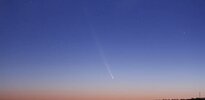ferball
desperately terminally-contrarian
- Jul 24, 2015
- 48,649
- 102,800
- AFL Club
- North Melbourne
Most amazing aurora in Tassie tonight.
Follow along with the video below to see how to install our site as a web app on your home screen.
Note: This feature may not be available in some browsers.
 BigFooty Tipping Notice Img
BigFooty Tipping Notice Img
Weekly Prize - Join Any Time - Tip Round 1
The Golden Ticket - MCG and Marvel Medallion Club tickets and Corporate Box tickets at the Gabba, MCG and Marvel.
Yes. Amazing feat.Caught the booster!



My pic from when it was visible in the morningI only found out on Friday so was a bit late to the party. Tonight might be one of the last nights to see Comet C/2023 A3. Here in Adelaide I could not see it with the naked eye, but I managed to capture it with 20+ second exposures on camera at Brighton Beach.
You need an unobstructed western horizon with minimal cloud, about 15 to 90 minutes after sunset. I read that you can still see it without a camera but with binoculars. This site really helped me:

Where is Comet C/2023 A3 (Tsuchinshan-ATLAS)? How to Find Comet C/2023 A3 (Tsuchinshan-ATLAS) in the Sky
All most complete and up to date resources needed to find Comet C/2023 A3 (Tsuchinshan-ATLAS) in the skytheskylive.com

What was the date? Could you see it with the naked eye?
6th of October at around 4:30am and only visible with my camera on a 20 sec timer. not sure its magnitude ever got enough to see with naked eye. It’s now moving away from us so is probably unlikely to get brighter.What was the date? Could you see it with the naked eye?
It's magnificent picture, thanks for posting.6th of October at around 4:30am and only visible with my camera on a 20 sec timer. not sure its magnitude ever got enough to see with naked eye. It’s now moving away from us so is probably unlikely to get brighter.
I made a life decision recently to stop procrastinating about doing things that give me joy. So I’ll probably stating staying up late or getting up early to take celestial object photos from now on. Glad I did this one as it’s a once in a lifetime comet. It’s also fading so it may not even last another orbit.It's magnificent picture, thanks for posting.

The article was a good read.I have been posting a lot about meteorite impacts. The S2 impact in South Africa was only recognised in 2014. It was huge and makes the dino killer look like a pebble. It occurred around 3.2 billion years ago and had a significant impact, pardon the pun, on Earth and perhaps the development of life. We have good evidence now there was already a variety of very simple life on Earth at that time. The SA scientists have found rock evidence the impacts churned up nutrients like phosphorus and iron that fed simple organisms. The giant fertiliser bomb is the catch phrase.
BBC have an article about it.

Giant rock boiled the ocean 3.2 billion years ago. It was a 'fertiliser bomb' for life
New research has uncovered what could very well be the key to our very existence.www.9news.com.au
Yes, it was. Episodic 'extraterrestrial intervention' has played a significant part in the development of life on Earth. No place for us if the dino's hadn't been wiped out.The article was a good read.
I really want a telescope now so I can start perusing the sky of all these objects. The wife tells me I have to either sell my rock tumbler or 600mm zoom lens to fund a new hobbyI think that's the exciting thing about comets: you never know how often a good one will swing by from the depths of space, never know how good it turns out to be, and how long its spectacle will last.
I wasn't into space in 1997 - did Hale-Bopp ever make a good appearance in the southern hemisphere, or was it really northern only? McNaught was great in 2007 but I still wasn't interested enough to take photos when I saw it that night at Grange Beach after sunset.
 .
.I have a Meade ETX 90 EC you can have. I bought it when Mars was very close to Earth in 2003. The kids and I really enjoyed looking at Mars but have never used it since. Happy to give it to you.I really want a telescope now so I can start perusing the sky of all these objects. The wife tells me I have to either sell my rock tumbler or 600mm zoom lens to fund a new hobby.


 theconversation.com
theconversation.com


 theconversation.com
theconversation.com
